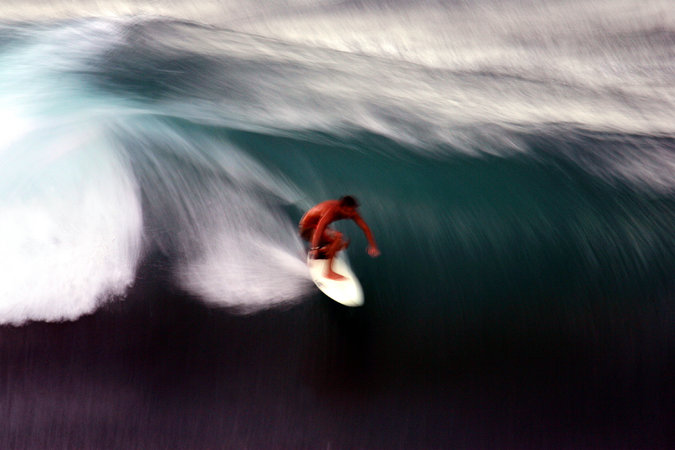Finnegan, William. Barbarian Days: A Surfing Life, Penguin Press, New York, 2015 (447pp.$27.95)
The impassioned surfer is a disciplined fanatic. Leaving everyday life behind, the disciplined fanatic abandons family, career, common comforts, romantic love, and even good health in a monomaniacal search for some “ur-experience”, usually described as “The Wave.” William Finnegan’s dad fretted over his son: “What could rightly have worried my dad about me and surfing was the special brand of monomania, antisocial and ill-balanced, that a serious commitment to surfing nearly always brought with it. The newly emerging ideal was solitude, purity, perfect waves far from civilization. This was a track that led away from citizenship, in the ancient sense of the word, toward a scratched-out frontier where we would live as latter-day barbarians.” Finnegan concludes that this was no dream of happy idleness; rather, the search was profoundly egocentric and selfless, dynamic and ascetic, radical in its rejection of the values of duty and conventional achievement. It was, in short, the dialectic of the mountain climber and the terrorist.
Finnegan, a staff writer at The New Yorker magazine since 1987, is a political journalist of note, and the author of three books about politics and international affairs. Having won two Overseas Press Club awards since 2009, his new book about the surfing life comes as a clear break in the arc of his writing. His new book, “Barbarian Days: A Surfing Life”, is by turns compelling and tedious. Composed first as a story for The New Yorker about a San Francisco physician surfer named Mark Renneker, the chapter titled “Against Dereliction” is a fine piece of work. Remarkable, however, is the first chapter called “Off Diamond Head” (where a youthful Finnegan confronts Hawaii’s iron-bound class and ethnic structures), a classic of non-sentimental social analysis, insightful personal reporting, and tender family remembrance. As Finnegan heads the book off around the world, it turns boring.
When Finnegan re-imagines his adolescence in Hawaii, with its frightening ethnic webs (how could Kuimuk Intermediate School and the unofficial Kill a Haole Day be anything but terrifying), bullying, public fights and posturing gang life—the necessary prelude to being included into the surfing fraternity, Finnegan composes brilliant mini-essays on teenage survival drama, outdoor adventure, and family solidarity. A bully called only “Freitas” sits behind Finnegan and pounds on his head with a two-by-four in class, “bonk, bonk, bonk.” As he turns surf nomad, an adult but not an adult, the book veers from character driven prose, indulging only in episodic romance with Finnegan and his friend Bryan wander the world (Tonga, Fiji, Java, Australia etc.). Waves get described in torturous, loving detail, Finnegan straining the bonds of English to capture each experience. Enthusiasts come and go (Bryan, Dominick, Jose), as do women (Caryn, Sharon, Sue in Australia, whose husband was in prison). Waves and breaks, reefs, rocks, dangers, lava cones and riptides, all swell forth and gently elide: Queen’s on Waikiki, the Cliffs, Ocean Beach, Will Rogers at Ventura, Kirra in northeast Australia and, most famously, Tavarua on Fiji. Mostly, these guys are resourceful beach rats, dragging their mutual obsession from outpost to outpost. These days, past sixty, Finnegan endures, surfing places like Montauk off Long Island and Jardin do Mar on Madeira.
As a kid in southern California, Finnegan grew up in a close-knit, large Catholic family. His father was a noted television producer and film editor while his mom, Patricia, was a talented, energetic, and water-loving woman with a wicked curiosity who made ends meet by raising her kids of carrot, apple and raisin salad seven nights a week. These parents let their children thrive on benign but intelligent neglect in an era when kids went out the door in the morning and rarely came back before dark. According to Finnegan, he approached surfing, like most kids back then in SoCal, through skateboarding, saved enough money to buy an old-fashioned long-board, then headed to Orange County’s beaches to find The Wave. As a spunky, skinny, do-anything pre-adolescent, he headed out the door of his dad’s newly purchased “beach shack” in Ventura and didn’t come back until dark. He was developing a way of life that would turn into a passion that would transmogrify into an obsession.
Make no mistake, surfers like Finnegan pay a high price for their passion. On Australia’s Gold Coast Finnegan muses about the surfing ailments: “Every…surfer seemed to have pterygia—sun caused cataracts, clouding their blue eyes. The scabby ears and purple noses and scarily mottled arms of the middle-aged were fair warning: basal-cell carcinoma (if not squamous-cell, if not melanoma) ahead. I already had pterygia myself, in both eyes…My years in the freezing ocean in Santa Cruz (Finnegan managed to cram in some college in both Santa Cruz and Missoula) had given me exostoses—bony growths in the ear canal, known as “surfer’s ear”—which were now constantly trapping seawater, causing painful infections, and would eventually require three operations.” Common were sprains, gashes, reef rashes, broken noses and torn ankle cartilage. He didn’t drown, but it wasn’t for want of trying.
And there’s the crux of the matter. “But surfing always had this horizon, this fear line, that made it different from other things. You could do it with friends, but when the waves got big, or you got into trouble, there never seemed to be anyone around.” Of course, why would there be? Finnegan, early on, learned the daunting truth of any obsession. “You were required—this was essential, a matter of survival—to know your limits, both physical and emotional. But how could you know your limits unless you tested them?” Finnegan is married now to Caroline. They have a child. He continues to surf, having presumably found his limits. If there is a spiritual payoff in the surfing life, it may come down to only that. In building bombs as in climbing mountains and surfing, only the dead have gone beyond their limits.


